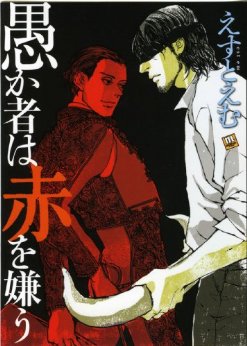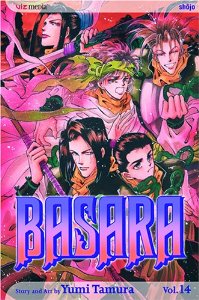Whenever I pick up and read a few volumes of Basara, I’m always struck by how much story and emotion Yumi Tamura is able to pack into a few pages. I’d started rereading Basara last year, but got distracted by having too many volumes of shiny new manga. The Manga Moveable Feast seemed like a great excuse to dig up these volumes again. These volumes cover Sarasa’s journey as she escapes from prison and wages war on the desert city of Suo, only to encounter the Red King. The battle doesn’t go the way either of them planned.
Sarasa is able to escape Abashiri prison with her comrades, but she doesn’t have time to settle back and appreciate freedom again. It is time to head south and take up the struggle to determine the fate of Japan. Ageha leaves Sarasa, saying that he can’t become a crutch to make things easier for her. She has to execute her plans on her own, based on her convictions. Shuri heads to his precious desert city of Suo, but things have changed there for the worse as the administrator there Momonoi attempts to remake it in the image of Kyoto by displacing the poor and blowing up buildings. Asagi prevents a reunion between Sarasa and Shuri in a southern market, because he thinks if they each find out the truth about each other now, it would be “too dull.” Sarasa and Shuri both head to Suo with drastically different purposes.
The struggle in Suo is portrayed in mental as well as physical terms. Sarasa meets up with Hozumi, Momonoi’s son who his a non-violent artist. His girlfriend Renko runs an underground newspaper in the city. Sarasa starts unsettling the city by plastering notices that “Tatara was here” on the walls, and even flying the message from a kite. Sarasa starts to reflect a bit about what it means to be both a strong and feminine woman after spending some time with Renko. Hozumi stages his own form of protest by painting elaborate pictures on the walls of buildings slated for destruction, so people hesitate to blow them apart.
When Shuri sees the wreckage of Suo, he’s angry at what it has become. Momonoi brutalizes both Hozumi and Renko. Sarasa and Shuri both go after Momonoi for different reasons. Sarasa is nervous about being in close proximity to the Red King, the man who destroyed her village. Shuri sees that he’s not welcomed as a savior in his treasured city, and begins to reflect that his previous philosophy about a good leader inspiring fear was mistaken. Sarasa’s reinforcements come, but her plan to use Momonoi’s own explosives to cut off the palace kills the water supply for the city. The Red King’s army executes a tricky sneak attack, and the star-crossed lovers seem like they are headed towards mutual destruction. Sarasa is devastated when she realizes that she’s bring more destruction to the people of Suo. A horrible sandstorm prevents the battle from progressing further, but rather than regroup with her comrades, Sarasa runs off and finds Shuri in the chaos.
It is a little unbelievable that Sarasa and Shuri have managed to keep their identities from each other for so long, especially considering the way they both tend to show up and meet each other right around the time that Tatara and the Red King have a skirmish. It is clear now that part of reason is that they honestly don’t care, and they are both blinded by love for each other so much that they aren’t going to stop and ask inconvenient questions when they could just enjoy each other’s company. This idyll is very short, and the Red King and Tatara’s army clash the next day and Shuri and Sarasa finally get a glimpse of each other from across the battlefield.
What follows is one of the most emotionally devastating scenes in the series, as Sarasa and Shuri react to this newfound knowledge in different ways. Sarasa slips into a fugue state, forcing out commands to kill the Red King, while Shuri mechanically tries to kill himself at the suggestion of his followers because his group is so clearly outnumbered by the rebel forces. Both armies flee the battle as King Ukon’s army approaches and Ageha takes Sarasa away in an attempt to bring back Tatara. Ageha thinks “Was he…that good? Why not just take me instead?” Ageha concludes that Sarasa isn’t his “woman worth dying for” and decides to leave. Sarasa ends up finding shelter with a local priest and his family, but her destiny isn’t going to let her sit back and do nothing.
Sarasa strikes up an odd friendship with Kikune, one of the White King’s spies. Sarasa and Kikune end up befriending Lady Purple, the Black King’s estranged wife. Lady Purple ends up being another type of mentor to Sarasa, but Sarasa’s emotional healing really begins when she’s reunited with her mother. In a very nurturing way, Sarasa’s mother asks her some pointed questions about the reasons why she was fighting and what she wants the future of Japan to be.
There’s some funny yet poignant exchanges happening as Asagi has rescued Shuri, who is undergoing his own emotional rehabilitation. Asagi is all but twirling his non-existent evil mustache in an attempt to get Shuri to have some sort of emotional reaction to him, but Shuri calmly accepts the prospect of being sold into slavery by his half-brother.
Overall, these volumes server as a great emotional climax to the first half of the series. The central mystery about what would happen if Sarasa and Shuri would find out about each other has been answered, and now they have to pick up the pieces of their lives yet again. While Ageha might have given up on Sarasa, it is clear that her destiny as Tatara will not allow her to just retire into the countryside and life out the rest of her life peacefully. Shuri has his own set of trials ahead, and it will be interesting to see how both of these powerful leaders manage to build a new Japan with such strong and well-connected enemies lining up against them. One of the strengths of Basara is the way Tamura will intersperse shorter, more personal adventures into the larger struggle with the extended cast. Having Sarasa and Shuri both on their own a little bit, without their customary support systems allows them to grow more as individuals, making the battles much more human. I’m glad I set aside the time to get back with my Basara rereading program, and I’ll likely finish up rereading the rest of the series outside of this week’s manga moveable feast.



